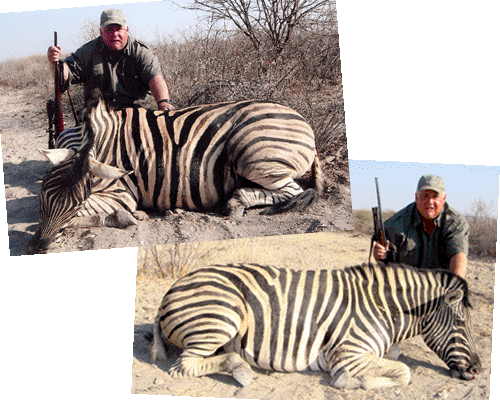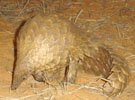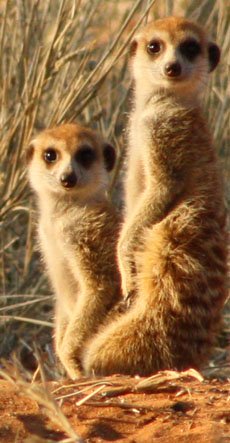For more information about our hunting safaris, don’t hesitate to reach out and contact us!
Zebra Double
by Stephan Hofmann
(Illinois, USA)
When I was 13-14 years of age some of my friends were presented with .410 shotguns which they used to hunt Ring-Necked Pheasant with. My father thought me too young to have a gun but he took me on some of his Pheasant hunting trips, none the less. I acquired a desire to hunt due to the stories told to me by my friends and the excursions with my father.
During my High School and University years I hunted every chance that I could; mostly small game such as squirrels, rabbits, and hares. I became a very proficient Ruffed Grouse hunter during my college years in Central Wisconsin, USA. I hunted the White-tailed Deer with a gun and a bow, but was never very successful. I also shot a lot with a variety of black powder muzzleloaders; a few of which I made myself.
I married in middle age and did not hunt for many years. My wife and I did a lot of backpacking especially the Wonderland Trail in Washington State, USA. My wife died of cancer and I decided that I wanted to try hunting again to fill up my vacation time. By this time I had worked in a Clinical Laboratory for a number of years. One of the sayings in a Clinical Lab is that when you hear the sound of hoofbeats, expect Horses, not Zebras.
This means that a Physician should look for the most likely cause of a Pathology, not an exotic cause or disease like a Zebra. The Doctor should expect Horses, not Zebras.
Little did I know that I was to venture to a land where one would expect Zebras, not Horses.
I hunted many of the animals in North America in the years following my wife's death including Moose, Mule Deer, Coyote, Bison, Merriam Turkey, Pronghorn Antelope, Elk, and Black Bear. I always hired an outfitter, therefore, was quite successful. My house started to look like Cabela's or Bass Pro Shops. My father always asked me when I was going to Africa. I always thought Africa was too expensive for a working man like me. I looked up the Cabela's website and found a hunt in Namibia that I could afford. I made my plans and prepared for the trip to Namibia, Africa.
One of the animals that was included in my hunt package was the Burchell's Zebra. The Burchell's Zebra was named after the great English explorer, William John Burchell, who traveled throughout Southern Africa in the early 19th century. Burchell described much of the flora and fauna of the region and named quite a few of the species including the Burchell's Zebra. I was enamored by this beautiful, robust, horse-like animal. I wanted a Zebra rug for the entryway to my house and perhaps a shoulder mount of a large stallion. The Zebra was near the top of my list of wanted animals next to the Kudu and the Gemsbok.
I practiced diligently with my Ruger .300 Win Mag until I could hit a six inch circle consistently at 200 yards. I would use 180 g Remington Cor Lokt ammunition. The Zebra and the Gemsbok were supposed to be very tough animals to bring down cleanly. The Zebra, with it's layers of fat, was especially tough.
In August of 2007 I was on Safari in Namibia, Africa. My Professional Hunter was Barry, a descendent of William John Burchell. Barry would guide me for ten days. Barry was a strong gentle giant of a man with refined tastes. He was urbane, articulate, and knew the names of every animal, bird, and plant that we encountered on Safari. I was in good hands.
Barry and I hunted hard for three days and saw a variety of animals. Barry wanted me to harvest exceptional trophies, therefore we passed on some animals that I was itching to shoot. On the fourth day of my Safari we ventured to Joss's Farm which was situated right next to Etosha National Park. Joss had a variety of animals on his Farm including Wildebeest, Eland, and Zebra. I told Joss that I really wanted a Zebra. He smiled and said, "We would find Zebra".
Joss's Farm was a paradise. I harvested an exceptional Gemsbok with a 180 yard shot. I also harvested a nice Red Hartebeest. I was very happy. However, I had come to a land where the sound of hoofbeats means Zebra; therefore at every bend in the road I expected to see stripes.
We saw herds of massive Eland running at full speed in a cloud of red dust. We saw Blue Wildebeest frolicking in the rich yellow grass. We saw beautiful Springbok posing strikingly in the savannah. We saw Ostrich fanning their wings and peering off into the long distance. Until, finally, we came upon a herd of Burchell's Zebras.
There were perhaps about ten Zebras in all. There was no lead stallion; they were led by a large mare. Barry asked me if I wanted the mare. It would make a fine shoulder mount. I told him I wanted it. I made sure my .300 Win Mag was loaded. I stabilized the rifle on my Harris Bipod. I put the safety at the fire position. At 165 yards I placed the mil dot reticule of the Nikon scope right on the triangular formation of stripes at the Zebra’s shoulder. I breathed inward lightly and slowly squeezed the trigger. The Zebra turned her head at the shot. Her head covered the triangular spot at her shoulder. The bullet went through the mare's eye and into her shoulder. She died instantly and fell instantly from the impact of the 180 g bullet.
The other Zebras milled around the mare. The mare had been their leader. With her gone they were confused. Barry picked out a nice young stallion and asked if I wanted it. I decided that I would shoot the stallion instead of the Mountain Zebra that was included in my hunt package. I wanted to score a double on Zebras. I carefully placed the scope on the young stallion and squeezed the trigger. He dropped next to the mare. I was elated. I had just harvested a double on two of the toughest animals in Africa, the Zebra.
I was overjoyed. We went up to the Zebras to take pictures. The rest of the herd stood off and made lonesome neighing sounds. While we were taking pictures the herd dispersed; probably to find a new leader.
I had a fine shoulder mount and a fine young unblemished skin for a rug. Joss had plenty of good Zebra meat with which to make Biltong. It had been a good days hunt.
These animals are now in my home; one on the "Africa Wall", and one in the entranceway to my house. I will always cherish these trophies.
I can now tell my co-workers that when you hear hoofbeats in the Clinical Lab to expect Zebras not Horses... especially when you are going to Africa!!
Stephan Hofmann
Comments for Zebra Double
|
||
|
||
|
||
|
||
|
||
|
||
Meaning of "Uitspan"
'Uitspan' is an Afrikaans word that means place of rest.
When the Boer settlers moved inland in Southern Africa in the 1800's, they used ox carts. When they found a spot with game, water and green grass, they arranged their ox carts into a circular laager for protection against wild animals and stopped for a rest.
They referred to such an action of relaxation for man and beast, as Uitspan.
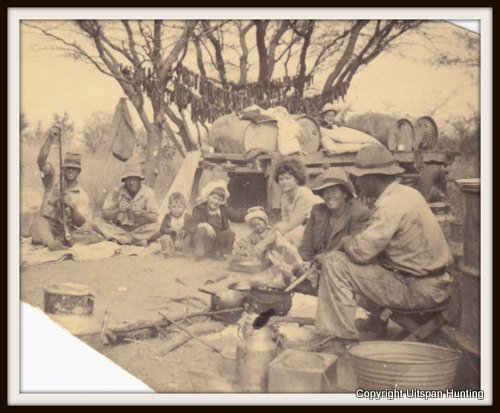
(Picture above of our ancestors.)
Did you know?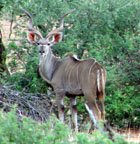 Greater Southern Kudus are famous for their ability to jump high fences. A 2 m (6.56 ft) fence is easily jumped while a 3 m (9.84 ft) high fence is jumped spontaneously. These strong jumpers are known to jump up to 3.5 m (11.48 ft) under stress. |
Did you know? Some animals have one sense more than man!The flehmen response is a particular type of curling of the upper lip in ungulates, felids and many other mammals. This action facilitates the transfer of pheromones and other scents into the vomeronasal organ, also called the Jacobson's Organ. Some animals have one sense more than man!The flehmen response is a particular type of curling of the upper lip in ungulates, felids and many other mammals. This action facilitates the transfer of pheromones and other scents into the vomeronasal organ, also called the Jacobson's Organ.This behavior allows animals to detect scents (for example from urine) of other members of their species or clues to the presence of prey. Flehming allows the animals to determine several factors, including the presence or absence of estrus, the physiological state of the animal, and how long ago the animal passed by. This particular response is recognizable in males when smelling the urine of a females in heat. |
